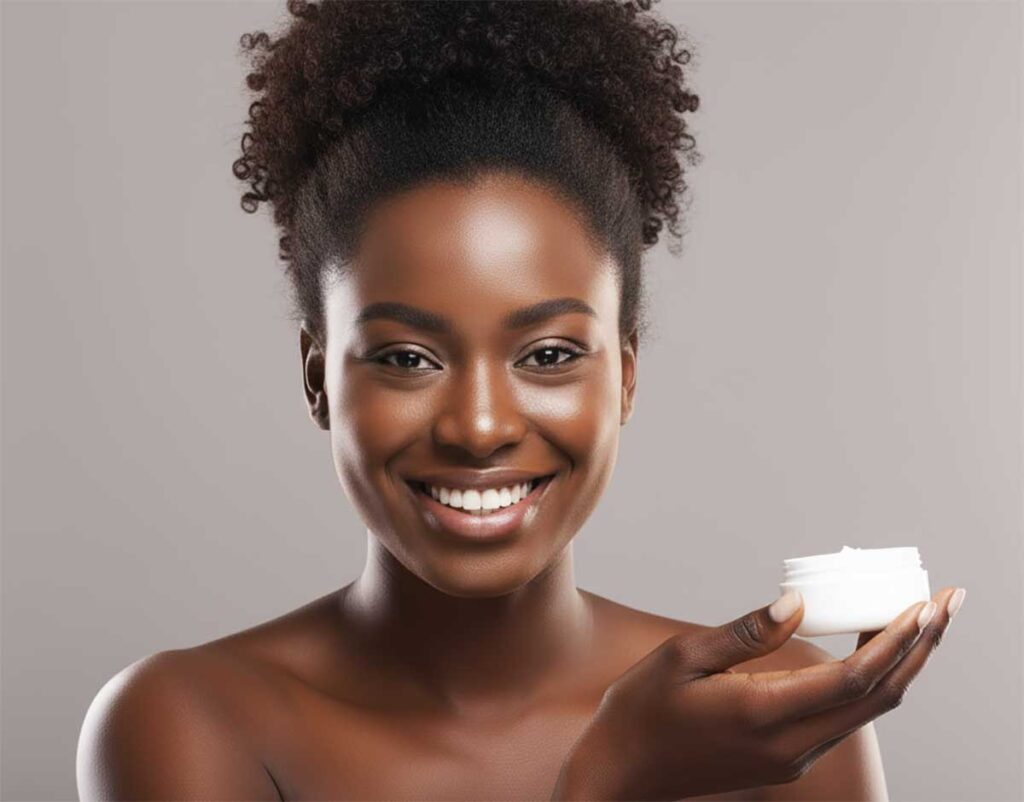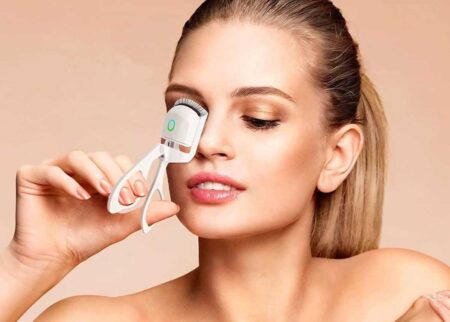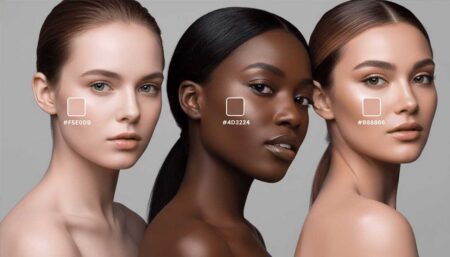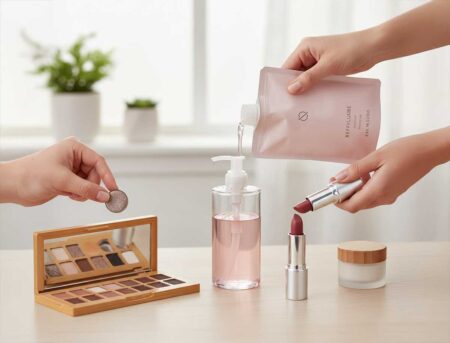Why Highly-Rated Products Work Perfectly for Caucasians but Poorly for Deeper Skin Tones
We explore the scientific, formulation, and historical reasons why beloved cosmetic and skincare products for Caucasian skin can produce ashy, dull, or irritating results on darker skin types.
1. The Cosmetic Divide: Why Do Products Fail?
If you have a deeper skin tone, you know the frustration: you see a glowing review online, buy the “universal” product, and end up looking ashy or dealing with a new dark spot. The problem isn’t your skin. The problem is that the beauty industry has historically used Caucasian skin as the default standard for product development.
The Hook (Key Takeaway): Highly-rated products fail deeper skin tones not due to quality, but due to fundamental differences in skin physiology, inflammation response, and formulation bias (especially mineral sunscreens and pigments).
This article is a deep dive, using both dermatologist research and industry history, to explain the scientific facts behind this issue. It’s about empowering you to choose products based on your skin structure, not just marketing hype.
Your Expertise: Iskra Banović, here. My focus at Blufashion is to cut through the beauty noise. My analysis is based on examining ingredient formulations and dermatological studies on a diverse range of skin tones to understand true product efficacy, not just surface-level results.
2. The Science of Skin: Structure, Melanin, and Photoaging
The biggest difference between light skin and dark skin is the quantity and distribution of melanin. Melanin is the pigment that gives skin, hair, and eyes their color.
Melanin and Inflammation Response
While all human skin has the same number of melanocyte cells, people with darker skin produce larger, more efficiently distributed packets of pigment called melanosomes. This gives natural protection against UV radiation, but it comes with a major tradeoff: a heightened inflammatory response.
- Hyperpigmentation Risk: For Black, Hispanic, and Asian skin (Fitzpatrick types IV-VI), any inflammation, acne, a scratch, or a harsh chemical peel, is far more likely to trigger excessive melanin production. This results in stubborn post-inflammatory hyperpigmentation (PIH) or melasma. Studies show pigmentary disorders are the second most common diagnosis for African-American patients, but fail to make the top 10 for Caucasian patients. (See authoritative research on PIH and Skin of Color).
- Advanced Pigment Management: The need for powerful, yet gentle, pigment inhibition is constant. For reviews of products specifically formulated to manage these issues, check out our deep-dive on the Dr. Reju-All Advanced Retino-Mela Serum review.
- Collagen Stability: Darker skin types show signs of aging later because melanin protects the underlying collagen network from UV breakdown. However, when aging does occur, it often presents as deep folds (nasolabial folds) rather than just fine wrinkles seen on lighter skin.
3. The Formula Gap: Ingredients and Stability
The core problem with product formulation is that ingredients are often chosen for how they look or perform on white skin, leading to failure on deep skin.
Ashiness and the Mineral Sunscreen Problem
Mineral sunscreens, which use Zinc oxide and Titanium dioxide, are widely praised for being gentle. However, these white powders sit on the skin’s surface and refract light.
On darker skin tones, this results in a visible white cast or an ashy, grayish complexion. Formulators often fail to micronize the particles small enough or use iron oxides (a tint) to counteract this effect. This means many “highly-rated” mineral sunscreens are completely unwearable for a large portion of the population.
Inflammatory Ingredients and Dark Spots
Certain ingredients common in popular skincare products designed for Caucasian skin can actively harm pigmented skin:
- Harsh Exfoliants: Aggressive physical scrubs or high concentrations of Alpha Hydroxy Acids (AHAs) can cause micro-tears and inflammation. On ethnic skin, this inflammation is a direct path to PIH and uneven skin tone. Gentle exfoliants like Mandelic or Lactic Acid are much safer bets.
- Drying Alcohols and Fragrance: Products that strip the skin barrier, like alcohol-heavy toners, increase Transepidermal Water Loss (TEWL). This strips the stratum corneum lipids, leading directly to the dull, ashy skin appearance common in darker women. (Learn more about cosmetic accessories that avoid skin irritation).
4. Performance Failure: Hyperpigmentation & Ashiness
4.1 Core Functionality: The Color Problem in Makeup
In makeup, the failure is often due to the pigment ratio. Traditional cosmetic formulations rely heavily on black iron oxide for dark shades. When mixed with the other foundation pigments (red, yellow, brown), too much black iron oxide results in a distinct, unattractive grey cast on brown skin and black skin.
Industry Anecdote (2025 Study): Research released in March 2025 identified that adding a small amount of Ultramarine Blue to foundation formulas creates warmer hues and reduces the grey cast, making the foundation look more skin-like. This highlights a decades-old formulation gap finally being addressed by targeted research.
4.2 Key Performance Categories
Category 1: Sun Protection (Invisible Finish)
For deeper skin tones, a sunscreen must be tinted (using iron oxides) or formulated with chemical UV filters. Otherwise, the white cast is a visual blocker. Since UV exposure still increases hyperpigmentation risk, the inability to wear sunscreen comfortably is a major skin health threat.
Category 2: Acne and PIH Management
On skin of color, acne isn’t just a bump; it’s a trigger for hyperpigmentation. Products formulated without this understanding often include high alcohol or harsh acne treatments that cause inflammation, leading to dark spots that can last months or years. The products themselves worsen the outcome.
5. The User Experience: Emotional & Practical Costs and Medical Gaps
Beyond the chemical failure, there’s a real human cost to shopping in an industry that excludes you.
The Medical Inclusivity Gap (A 2025 Focus)
The lack of visual representation extends to medicine. Dermatologists are often trained on images of conditions (like eczema, psoriasis, or lymphoma) as they appear on lighter skin, where inflammation appears red. On darker skin, these conditions can appear purple, gray, or yellow.
Ongoing 2025 Development: Because of this gap, major organizations like the American Academy of Dermatology are prioritizing the development of new atlases and digital tools with diverse imagery. This is a crucial, ongoing effort to reduce misdiagnosis and ensure skin health equity. (A great resource is the Skin of Color Atlas).
The Shopping Experience and “Shade Tax”
Shopping for foundation or concealer used to be a frustrating guessing game for people with darker skin. While the industry is improving, a 2025 report confirmed that 53% of black consumers still report having difficulty finding suitable beauty products. This friction erodes brand loyalty and trust in the entire cosmetic industry.
6. The Inclusivity Index: The Fenty Effect and Industry Shift
The good news is the market has begun to correct itself, largely thanks to market leaders who forced change.
The “Fenty Effect” Case Study
When Fenty Beauty launched in 2017 with 40 shades of foundation, it wasn’t just a product launch; it was a market correction. It exposed how many legacy makeup brands had intentionally or negligently ignored a massive consumer base.
Fenty didn’t just add a few dark shades; they engineered a truly inclusive range of skin tones with varied undertones. This move established a new industry benchmark, forcing competitors to expand their shade offerings from the historical 10-15 shades to 30, 40, or even 50 shades to remain relevant.
2025 Inclusivity Metrics
In 2025, inclusivity is a strategic imperative. Brands that are certified as inclusive are financially outperforming their less inclusive competitors by a clear margin. The market is rewarding authenticity and representation.
7. Key Takeaways and Action Points
What the Industry is Getting Right
- The Fenty Effect cemented the need for wide shade offerings.
- Skincare is increasingly focusing on ingredients to prevent hyperpigmentation (e.g., advanced brightening serums).
- Research is identifying the “grey cast” problem (Ultramarine Blue solution) for better pigment matching.
Where the Gaps Still Exist
- Mineral sunscreens often lack adequate tint for a seamless blend.
- The medical/dermatology field still suffers from a severe lack of images and training material for ethnic skin.
- Many brands still formulate with harsh alcohols and fragrances that trigger inflammation and PIH on pigmented skin.
8. The Road Ahead: Research and Regulation
The next wave of skincare innovation will move beyond just adding niacinamide to everything. We expect greater focus on:
- Barrier Function: Products focusing on restoring Ceramides and preventing Transepidermal Water Loss, which directly fights the ashy skin phenomenon.
- Visible Light Protection: Since Visible Light (VL) is a major trigger for hyperpigmentation in dark skin, tinted sunscreens using iron oxides will become the standard for true protection.
- AI Testing: Brands are now using AI to analyze their marketing and product development for blind spots in inclusivity, ensuring they test on a truly diverse range of skin tones before launch.
9. Recommendations for Deeper Skin Tones
Best For:
- Products containing Ceramides and Hyaluronic Acid.
- Gentle chemical exfoliants (Mandelic, Lactic Acid).
- Tinted mineral sunscreens or chemical sunscreens.
Skip If:
- Ingredients include SD Alcohol or Denatured Alcohol.
- The product leaves a heavy white cast.
- Physical scrubs (walnut shells, apricot kernels).
Alternatives to Consider:
- Brands founded by or focused on Black or Asian women (e.g., Fenty, Danessa Myricks).
- For accessories, focus on gentle application, like this nail pen set.
10. Where to Find Truly Inclusive Products
Don’t waste time on brands that offer only 15 shades. Look for brands that list their shade count and specifically mention testing across all Fitzpatrick skin type’s (I-VI).
When shopping for personal care items, whether it’s the best fragrance for men or luxury perfume brands, always prioritize retailers that actively sort and promote inclusive beauty brands. Look for platforms that use technology to help you find the correct undertone (red, yellow, neutral) as this is more critical than just the depth of the skin tone.
11. Final Verdict: Closing the Gap
The Inclusivity Index (Out of 10)
This score is our baseline metric for the industry’s historical starting point, which requires dynamic updating.
Summary: Understanding the Root Cause
The core lesson here is that a product being rated 5 stars by a majority of Caucasian skin users means nothing if the formula wasn’t built for melanin-rich skin. The failures we see are not user error; they are a direct result of a lack of intentional, inclusive product development that failed to account for physiological and inflammatory differences in skin.
Bottom Line: The responsibility lies with the beauty brands. They must continue investing in research on darker skin types and reformulating products to prevent ashiness, strengthen the skin barrier, and eliminate inflammatory triggers that lead to hyperpigmentation.
12. Evidence & Proof: Interactive Tools and Visuals
Interactive Tool: Fitzpatrick Skin Type Concerns
The Fitzpatrick scale (Types I-VI) correlates to the natural pigmentation level and the skin’s reaction to the sun. Click your skin type below to see your primary risk factor and focus area.
Click a Fitzpatrick Skin Type above to see the primary skin concerns for that category.
Visualizing the Pigment Problem (Interactive Images)
To fully illustrate the formulation failures, the article requires dynamic visuals.
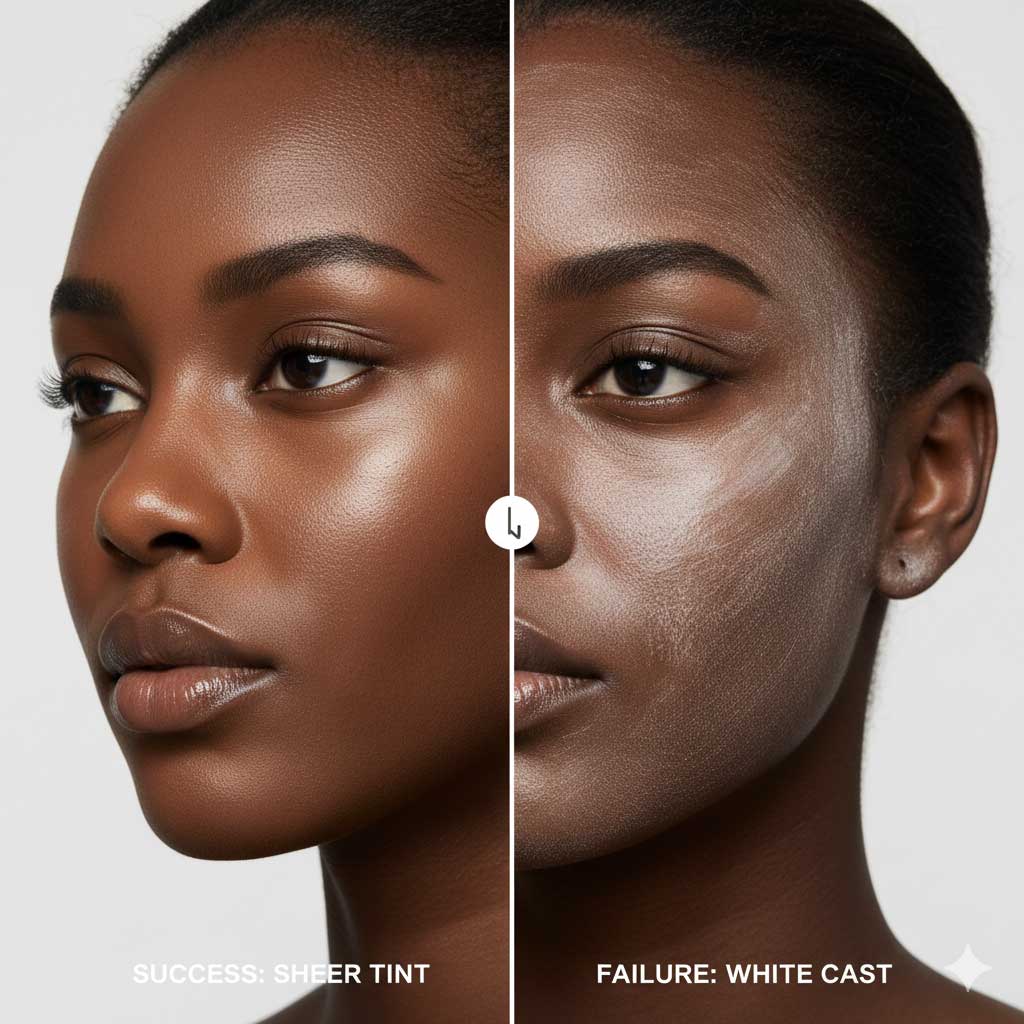
Visualizing the Pigment Problem: Interactive slider showing white cast vs. sheer tint on deep skin. (Required to show failure vs. successful blending).
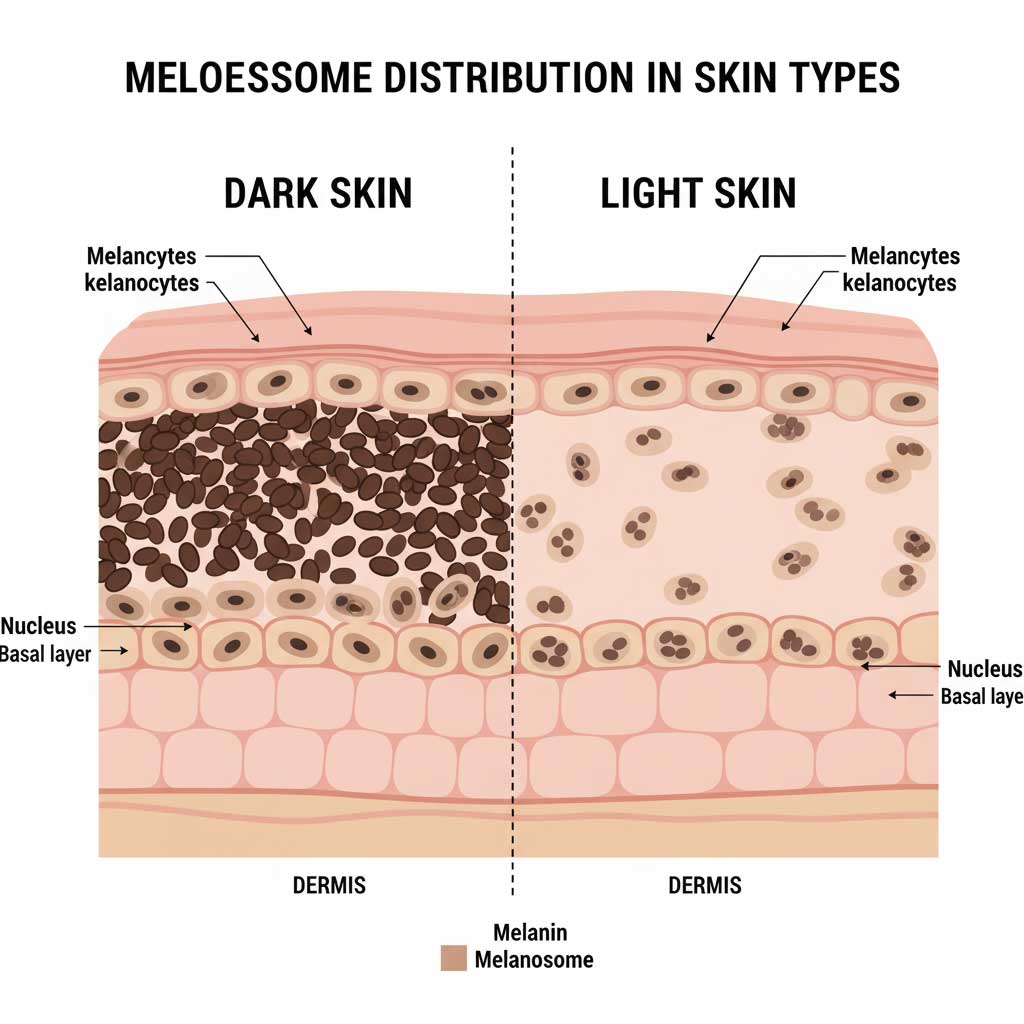
Melanin Melanosome Diagram: Diagram comparing large, individual melanosomes in dark skin vs. clustered melanosomes in light skin. (Essential for explaining Section 2 science).


